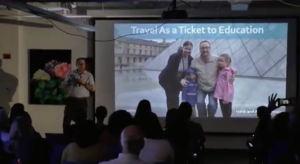
This has been a good year as a speaker for me. Early this year, I decided that I wanted to move from being a “presenter” to a “speaker”. It meant that I needed to change in numerous ways. Change is not easy for some. In fact, most people do not embrace change.
To me presenting is being able to speak to content on a slide deck. Speaking is being able to disseminate information in an engaging manner.
Early in my career, I read the book, Who Moved My Cheese, which is about handling change. From then on, I knew that change was the key to progression and success. Anytime change presented itself, I learned to adapt and go with he flow. I am not saying that it was easy, or that it that it is now, but I can say it is more habitual.
I had a chance to speak nine times this year. People that speak for a living might not think that is a lot, but to me it is. I had to work hard to get some gigs and others found me. There was one situation where I was working a sponsor table for a non-profit conference and became a last minute addition to the speaking line-up.
I overheard some of the staff talking about how three of the speakers did not make it to the conference. After hearing this, I went and spoke with the conference organizer. I told her that I would be willing to speak and she said “you are on in 30 minutes!”
I consider myself to be engaging and passionate. That is a great foundation for any speaker. With little preparation, I was able to adapt a slide deck and pull off a talk on email marketing at the non-profit conference. Afterwards, I had a chance to look at the review slips and my talk had high ratings overall. In hindsight, I know that I could have done better.
To become a better speaker, I needed to ensure that I kept myself outside my comfort zone, as should anyone. My goal was to gain more confidence, become a better story teller, reduce the use of filler words, and make better uses of gestures when on stage.
Build Confidence
What I can tell you about gaining speaking confidence is to just do it as much as you can. I use webinars, a podcast, and workshops to fill the void between speaking gigs. This helps with practicing your content so that you can know it better for larger venues. Over time, you build knowledge and stories that you can use to help improve your future presentations.
Another confidence builder for me came from an opportunity that arose earlier this year when I joined a local professional speaking group that provides a wealth of information and support. I am grateful to have found this group and really enjoy all the great members.
Use Stories
For what I speak about, email marketing and automation, it would be easy create slides that have a lot of bullets and make the mistake of speaking to each one. If you use this method, people will walk away remembering a few things about your talk. One to three items if you are lucky.
If you are more engaging by providing examples and stories, you will be more memorable and inspiring. People will remember more about you and your message. Stories are more memorable than bullet points. You will find that you will grow as a speaker because you will obtain better engagement and feedback, not to mention the fact that more people will be willing and able to spread your message to others.
Training and Practice
To help with my speaking delivery, I was lucky enough that attend a speaking workshop earlier this year. The workshop was facilitated my MillsWyck Communications in Cary, NC. It was a two day class where 12 people attended and went through some speaking exercises. We were recorded numerous times and were able to take the footage home with us.
It was interesting to see the transformation over the course of the workshop. We worked on gestures, inflection, adding value, and removing filler words. For me, the biggest take away was how the facilitator was able to assist with coaching on these items. He would give either non-verbal or verbal feedback while you were speaking front of the group to help make improvements. Peer feedback was also helpful.
The most enjoyable thing for me was when a participant was speaking and used the word “so”, Alan Hoffler, the workshop facilitator, would shout out “No so for you!”
When it happened to me , I found that I did not realize that I used a filler word and it helped shock me into mentally paying attention. What you need to do is slow down the word tracks in your mind and catch the filler words before they become verbal. This will also slow down you speaking cadence, which is good.
Make huge gestures when speaking. But wait, can you? When I felt like a made a huge gesture, it was mediocre at best. How do I know this? I watched the video from the workshop. To help I prove on this, use huge gestures in the mirror when you are practicing your talks. It helps me, but I have a long way to go.
Create Content
Blogging, podcasting and writing books helps you develop a library of content to pull from. I have found that the more I create content outside speaking, the more stories and information I have for my talks. It also helps build content confidence, for both you and the audience.
Have a Value Proposition
When you speak you need to know that there are various types of people in the audience. There are people that want to learn from your material, there are also those that may be there because someone sent them and they may not be fully interested in you or what you have to say. Your session or talk was just convenient to them, so they are filling a seat. Then there are all people that may have, by chance, come to hear you speak and may be swayed to pay attention to your talk.
Regardless of the break down of your audience, you need to bring value to the whole audience. It needs to be for them and not you. You are not there to tell people about you or to tell them what to do. You need to inspire. You must invoke emotion and create engagement.
When you open your talk, you need to have a value statement or proposition. Use the WNHHC method. First, tell them what they will want to do or learn. Then tell them why they need to listen. Next tell them how they can take action in their life or career to meet the want and need. Then help them understand and implement what it will take to meet the proposition you present. Lastly, offer a huge call to action so that people leave the room ready and eager to take control and remember your talk.
A special thank you goes out to Stephanie Scotti with Professionally Speaking for helping me create an efficient method for creating my value propositions.
These 5 things have helped me tremendously with becoming a speaker this year. I hope that they will help you as well. Next year, I am putting myself out of my comfort zone by challenging myself to speak more in 2018 than I did in 2017. Do you think that I will meet my goal? What goal do you have as a speaker for 2018?
Here is to a great new year!
Author
-

Hank is an author, speaker, podcast host and Director of Operations at Kickbox, a Ziff Davis company. With a passion for all things digital and social, combined with more than 25 years of experience in sales and marketing, he has been dubbed the Digital Marketing Infotainer because he makes marketing fun and successful.
View all posts
